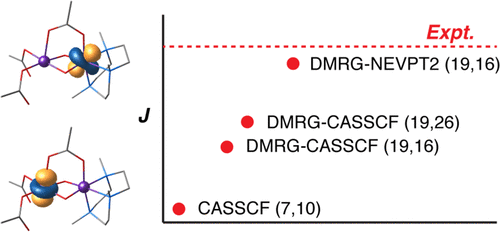当前位置:
X-MOL 学术
›
J. Chem. Theory Comput.
›
论文详情
Our official English website, www.x-mol.net, welcomes your feedback! (Note: you will need to create a separate account there.)
Exchange Coupling Interactions from the Density Matrix Renormalization Group and N-Electron Valence Perturbation Theory: Application to a Biomimetic Mixed-Valence Manganese Complex
Journal of Chemical Theory and Computation ( IF 5.5 ) Pub Date : 2017-12-20 00:00:00 , DOI: 10.1021/acs.jctc.7b01035 Michael Roemelt 1, 2 , Vera Krewald 3 , Dimitrios A. Pantazis 4
Journal of Chemical Theory and Computation ( IF 5.5 ) Pub Date : 2017-12-20 00:00:00 , DOI: 10.1021/acs.jctc.7b01035 Michael Roemelt 1, 2 , Vera Krewald 3 , Dimitrios A. Pantazis 4
Affiliation

|
The accurate description of magnetic level energetics in oligonuclear exchange-coupled transition-metal complexes remains a formidable challenge for quantum chemistry. The density matrix renormalization group (DMRG) brings such systems for the first time easily within reach of multireference wave function methods by enabling the use of unprecedentedly large active spaces. But does this guarantee systematic improvement in predictive ability and, if so, under which conditions? We identify operational parameters in the use of DMRG using as a test system an experimentally characterized mixed-valence bis-μ-oxo/μ-acetato Mn(III,IV) dimer, a model for the oxygen-evolving complex of photosystem II. A complete active space of all metal 3d and bridge 2p orbitals proved to be the smallest meaningful starting point; this is readily accessible with DMRG and greatly improves on the unrealistic metal-only configuration interaction or complete active space self-consistent field (CASSCF) values. Orbital optimization is critical for stabilizing the antiferromagnetic state, while a state-averaged approach over all spin states involved is required to avoid artificial deviations from isotropic behavior that are associated with state-specific calculations. Selective inclusion of localized orbital subspaces enables probing the relative contributions of different ligands and distinct superexchange pathways. Overall, however, full-valence DMRG-CASSCF calculations fall short of providing a quantitative description of the exchange coupling owing to insufficient recovery of dynamic correlation. Quantitatively accurate results can be achieved through a DMRG implementation of second order N-electron valence perturbation theory (NEVPT2) in conjunction with a full-valence metal and ligand active space. Perspectives for future applications of DMRG-CASSCF/NEVPT2 to exchange coupling in oligonuclear clusters are discussed.
中文翻译:

密度矩阵重整化组和N电子价态微扰理论的交换耦合相互作用:在仿生混合价锰配合物中的应用
寡核交换耦合的过渡金属络合物中磁能级能的准确描述仍然是量子化学面临的巨大挑战。密度矩阵重归一化组(DMRG)通过启用前所未有的大活动空间,使这种系统首次轻松地进入了多参考波函数方法的范围。但是,这是否可以保证预测能力的系统性提高?如果可以,在何种情况下可以保证?我们在使用DMRG的实验系统中确定了实验参数,该实验参数是实验表征的混合价bis-μ-氧代/μ-乙酰Mn(III,IV)二聚体,它是光系统II释氧复合物的模型。所有金属3d和桥2p轨道的完整活动空间被证明是最小的有意义的起点。DMRG可以很容易地访问到它,并且极大地改善了不切实际的纯金属配置交互或完整的活动空间自洽字段(CASSCF)值。轨道优化对于稳定反铁磁状态至关重要,同时需要对所有自旋态进行平均的状态方法,以避免与各态特定计算相关的各向同性行为的人为偏离。选择性包含局部轨道子空间使得能够探测不同配体和不同超交换途径的相对贡献。但是,总的来说,由于动态相关性的恢复不足,全价DMRG-CASSCF计算未能提供交换耦合的定量描述。N电子价态扰动理论(NEVPT2)结合全价金属和配体活性空间。讨论了DMRG-CASSCF / NEVPT2在寡核簇中交换交换的未来应用的前景。
更新日期:2017-12-20
中文翻译:

密度矩阵重整化组和N电子价态微扰理论的交换耦合相互作用:在仿生混合价锰配合物中的应用
寡核交换耦合的过渡金属络合物中磁能级能的准确描述仍然是量子化学面临的巨大挑战。密度矩阵重归一化组(DMRG)通过启用前所未有的大活动空间,使这种系统首次轻松地进入了多参考波函数方法的范围。但是,这是否可以保证预测能力的系统性提高?如果可以,在何种情况下可以保证?我们在使用DMRG的实验系统中确定了实验参数,该实验参数是实验表征的混合价bis-μ-氧代/μ-乙酰Mn(III,IV)二聚体,它是光系统II释氧复合物的模型。所有金属3d和桥2p轨道的完整活动空间被证明是最小的有意义的起点。DMRG可以很容易地访问到它,并且极大地改善了不切实际的纯金属配置交互或完整的活动空间自洽字段(CASSCF)值。轨道优化对于稳定反铁磁状态至关重要,同时需要对所有自旋态进行平均的状态方法,以避免与各态特定计算相关的各向同性行为的人为偏离。选择性包含局部轨道子空间使得能够探测不同配体和不同超交换途径的相对贡献。但是,总的来说,由于动态相关性的恢复不足,全价DMRG-CASSCF计算未能提供交换耦合的定量描述。N电子价态扰动理论(NEVPT2)结合全价金属和配体活性空间。讨论了DMRG-CASSCF / NEVPT2在寡核簇中交换交换的未来应用的前景。


























 京公网安备 11010802027423号
京公网安备 11010802027423号